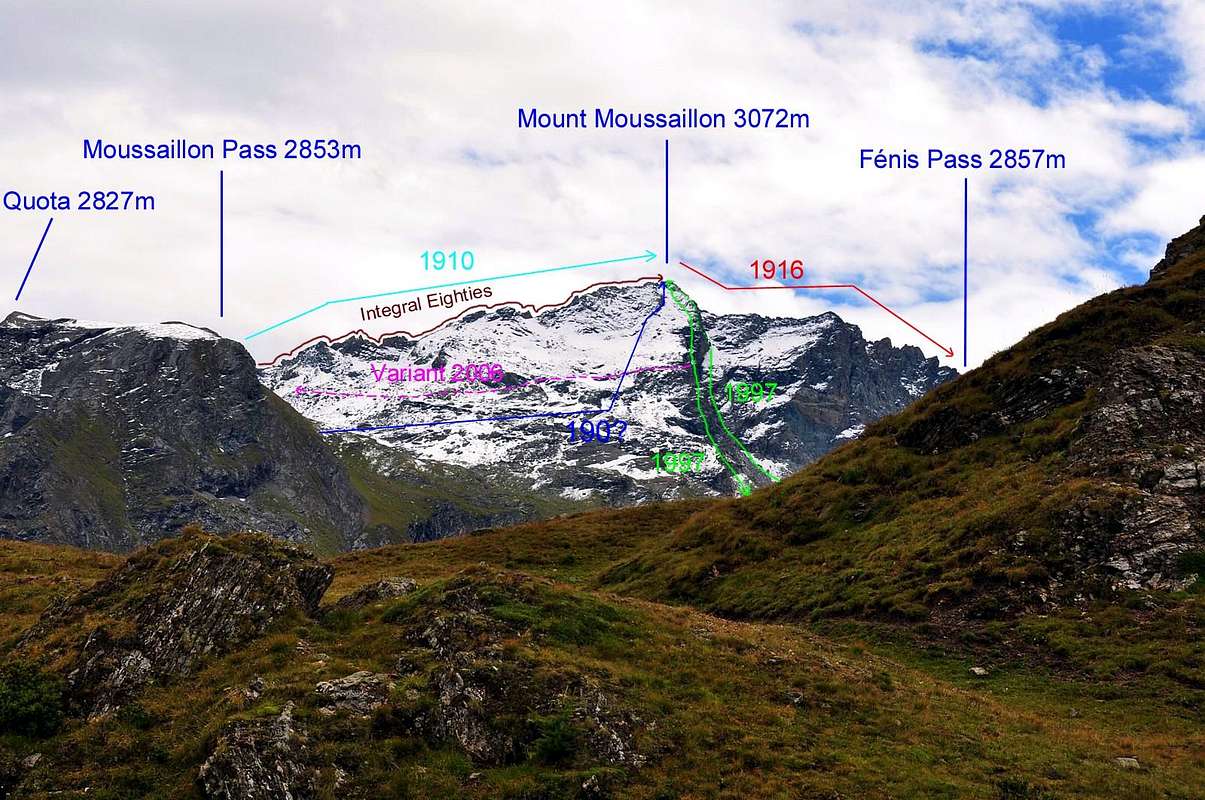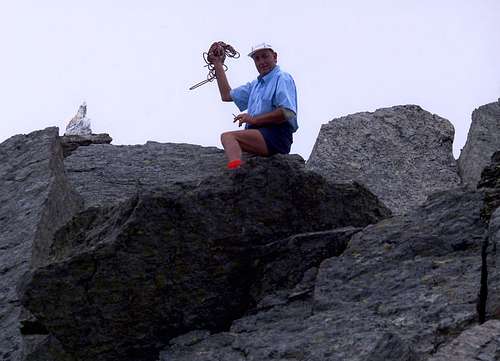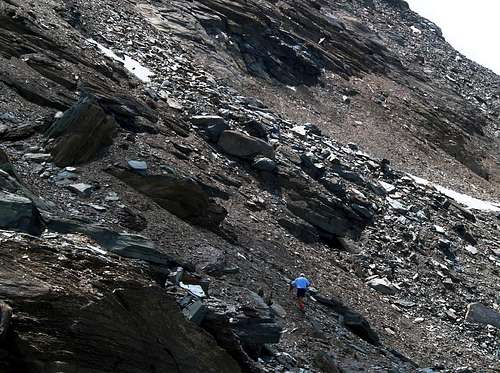-
 9306 Hits
9306 Hits
-
 88.19% Score
88.19% Score
-
 26 Votes
26 Votes
|
|
Mountain/Rock |
|---|---|
|
|
45.61570°N / 7.50431°E |
|
|
Mountaineering |
|
|
10079 ft / 3072 m |
|
|
Overview



First Ascents
- First on the summit (route?): Royal gamekeeper Domenico Perruchon of Champorcher at the beginning of XX centuries.
- W-SW Ridge (from Fénis Pass): Gustavo Adolfo De Petro, solo, (Jul 13th, 1916), in descent to Fénis Hill.
- NW Face: Osvaldo Cardellina, solo, (Aug 13th, 1997), in ascent, in day from Barche/Lovignana up to the Grand'Alpe and Moutsaillon Loch.
- NW Edge: Osvaldo Cardellina, solo, (Aug 13th 1997), in descent, in day into Comba Tersiva to Lac Moutsaillon, Cuneu, Grand'Alpe, Meney Damon and Desòt, Robbio, Marqueron, Lovignana, * first replay by two/third of crest: Osvaldo Cardellina and Emilio Bertona, (Jul 23th, 2006), in descent with same route.
- N Slope (Standard Route): Domenico Perruchon in several times in ascent and in descent, at the beginning of XX Centuries, ** first replay well-known: the Ligurian mountaineers Giovan Battista Bozzino and Giovan Battista Gritti, (Aug 15th, 1910), in descent. N Slope and E Crest in final part (Left or East Variant directly to Eastern Ante Top 3.016 meters): Osvaldo and Alessandro Cardellina, (Sep 18th, 2005), in ascent, in day from Grand'Alpe, Comba Tersiva before Gran Reye, Moussaillon Torrent, Lake (* not traced in photo but just in left by blue line of Normal Via); in descent through Normal to Moutsaillon Lake, Col, Grand'Alpe.
- E-NE Crest (from Moussaillon Pass, partially route): Giovan Battista Bozzino and Giovan Battista Gritti, (Aug 15th, 1910), in ascent.
- E-NE Crest (Integral from Moussaillon Pass): Roberto Nicco and Company, in Eighties, in ascent from Champorcher Valley (Dondena).
- Southern Spur (Direct Line to Top): Osvaldo Cardellina and Alessandro Cardellina (Aug 15th, 2005), in ascent, in day from Dondena, paths to Moutsaillon/Fénis Passes, Pontonnet Lake; in descent by North Slope or Normal with crossing to Moutsaillon Col and towards Champorcher Valley (Dondena).
- S-SE Face (Way of the Big S): Osvaldo Cardellina, solo, (Jul 14th, 2006), in ascent, in day from Dondena, paths to Moutsaillon/Fénis Passes, Pontonnet Lake; in descent through integral route on SW Ridge up to the Fénis Hill and same route towards Champorcher Valley (Dondena).
Getting There
BY CAR:- From Torino, Milano, etc: Motorway A5. Exit Pont Saint Martin for then to continue on SS.26 toward Hone Bard.
- From Torino, Milano, etc: Motorway A5. Exit Nus Village for Fénis Village.
- From Switzerland: through the Grand Saint Bernard Tunnel or the namesake pass. Drive to Aosta, Fénis Village or Verrès and Hone Bard.
- From France: through Mont Blanc Tunnel or Petit Saint Bernard Pass. It isn't necessary to take Motorway A5: you can drive on SS.26, in the direction of Aosta and Fénis Village or Verrès and Hone Bard.
- Aeroporto "Corrado Gex" Saint Christophe (Aosta).
Approach from Fénis/Clavalité
Approach from Champorcher/Dondena
Da Dondena (2.110 m), passando presso l'omonimo Rifugio (2.192 m) seguire la strada sterrata poderale, concomitante con il sentiero n° 7B,7C, Alta Via della Valle d'Aosta n° 2, nonché Storica Strada Reale costruita dai Savoia; (scorciatoia a N dopo il ponte sino all'Alpe Dondena 2.171 m ed al successivo bivio 2.242 m) per la Finestra di Champorcher sino al piccolo e grazioso ponte che attraversa il Torrente Ayasse a quota (2.334 m). Proseguire lungo il sentiero n° 8B per il Colle Moussaillon (2.853 m), lasciando a destra (NE) quello (n° 8C) per il Col Fussì/Mont Glacier, con una prima deviazione verso queste mete. Con un breve diagonale a sinistra (NO) e susseguenti quattro tornanti terminanti in un poco più lungo diagonale nell'opposto senso, si perviene ad una seconda ramificazione dei sentieri:
a) - con la deviazione a sinistra (O-NO) quello siglato 8A, che si indirizza ai Colli di Fénis, per l'omonima Valle, e di Pontonnet, attraversante all'Alto Vallone dell'Urtier in Val di Cogne;
b) - con quella di destra verso NE, e sempre con il sentiero 8C, qui presentante una variante, con lungo diagonale in leggera ascesa, verso l'imbocco del Vallone del Mont Glacier ((3.186 m; il più elevato del piccolo Sottogruppo al quale dona nome) che dà accesso anche al Col Fussì (2.910 m), traslocando in Val Fénis verso le Alpi del Cuneux e dell'Etsely. Entrambe queste due importanti deviazioni avvengono nei pressi del tornante in quota 2.540 m, che quindi funge da trivio. Trascurando queste due, proseguire invece decisamente verso Settentrione con il sentiero n° 8B e per mezzo di una serie di stretti tornanti a zig-zag ed un breve diagonale a sinistra nella parte finale raggiungere il colle, in un tratto di rocce frantumate ed abbastanza ripide; dallo stesso scendere un'ottantina di metri con percorso semicircolare a NW al Laghetto Moussaillon (2.766 m), incastonato tra le rocce, e quindi ricongiungersi all'itinerario precedente o Via Normale attraverso la Valle di Fénis-Altipiano della Clavalité e parte iniziale della Comba Tersiva (E; 2h'00/2h'30 dal Villaggio di Dondena).
VARIANTE "BASSA" DI DESTRA: Da Dondena scendere brevemente al ponte sul Torrente Ayasse, ma non attraversarlo; passando sotto la piccola palestra di roccia (dedicata a due alpinisti di Champorcher) continuare invece direttamente verso W lungo la sponda idrografica sinistra del torrente. Attraversare il torrentello proveniente dal Lac Gelé (sito alle pendici Meridionali del Glacier) e procedere successivamente ed agevolmente per 1,5 Km attraverso una lunga prateria con qualche rovina sino a raggiungere una strettoia, dove l'Ayasse si inforra tra rocce levigate impedendone il passaggio; risalire verso destra fiancheggiando una presa d'acqua recintata e, con percorso ripido su una esile traccia sul pendio erboso, risalire al promontorio soprastante 2.736 m. Non toccarne la sommità scartandola a destra di una trentina di metri (oppure raggiungerla, magnifico belvedere ed ottimo punto fotografico) e scendere in breve al sottostante grande "plateau" erboso ricongiungendosi al precedente itinerario. Iniziare la più ripida salita tramite il sentiero n° 8A/8B/8C che, come già sopraddetto, si divide in ramificazioni varie a seconda delle destinazioni, raggiungendolo laddove quest’ultimo inizia a rimontare la china con una serpentina di mezza dozzina di brevi, nonché stretti tornantini (E; 0h'45, un pò più rapido del precedente percorso e sicuramente maggiormente suggestivo e men che meno affollato e noioso).
Route
From the Lake Moussaillon (2.766m), situated to Northeast of the Mont Moussaillon and as soon as under the homonym Hill (2.846m), to abandon the path n° 5D that, with a last steep line toward Southeast, it reaches it and instead to continue verse West-southwest long, steeply, stony ground; to overcome with one easy, but fatiguing, crossed from East to West, in parallel to the impending and long E-NE Rdge, three rocky bands and some lean snowfields (you see photo of emilius, July 2006). Revolving, not without some small problem, great rocks with relative ravines, to progressively go himself supporting on the left (South) toward the triangular one and terminal Slope N in South of the quota 2.816 meters. and toward quota 2.900/2.925 meters). To easily go up again the last 150/70 meters, but with greater work, overcoming the steep slant among splinters, soil and small rocks and always supporting himself and more toward left, almost thin against a brief rocky rib, descending in sinuous way from the indented Crest E-NE. Reached this last, to arrive with a steep line to a very hold fork with big vertical jump falling toward South, above the "Chemin du Roi" (or Real Road that, departing from the Village of Dondena, it reaches the Lac Pontonnet (2.072m), as soon as before landing to the two Necks of Fénis (2.857m; adressed to the Comba also Basin Tersiva at the end last of our valley) and subsequently to the fortifications of the With the Pontonnet (2.897m), toward the Walloon of the Urtier to the Oriental limit of the Valley of Cogne). From this point to decidedly cross and as soon as under the E-NE Ridge to the right (Southwest) and, through a plate with crack (I°+/II°-), to reach the opposite Crest watershed W-SW, that salt drawing origin really from the Fénis Pass; to turn to the left decidedly then and, for easy and Cyclopean boulders that induce to a pleasant gymnastics, to touch the Peak, on which an unusual block is placed in quartz, by the form pyramidal pseudo (EE/A; F+/PD-; 6h'00/7h'00 from the Fraction of Barche; 1h'00/1h'15 from the Little Pond of the Moussaillon).
Difficulty
This route can be considered EE/A (Expert Excursionists/Mountaineers); F+/PD-.Equipment
Standard mountaineering equipment. Rope recommended.Huts
From FENIS: Bivacco Borroz-Rotary Val Clavalité (2.156m). Difficulty: E (Hikers). Sleeps 24. Always opens. Reachable from Clavalité Valley.

Campings
Remember that free camping is forbidden (except for emergency reasons, over 2.500m, from darkness until dawn).Mountain Conditions
- You can get meteo information at the official site of the Regione Valle d'Aosta:
- Valle d'Aosta Meteo
Webcam
- WEBCAM on Aosta Valley:
- Webcam
Books and Maps
BOOKS:- "Guida delle Alpi Occidentali" di Giovanni Bobba e Luigi Vaccarone C.A.I. Sezione di Torino Volume II (parte II), 25 Maggio 1896.
- "Guida dei Monti d'Italia – Emilius Rosa dei Banchi-Parco del Mont Avic" di Giulio Berutto e Lino Fornelli - Club Alpino Italiano/Touring Club Italiano, Marzo 2005.
- "Diari Alpinistici" di Osvaldo Cardellina e Indice Generale accompagnato da Schedario Relazioni Ascensioni 1964-2019 (inediti).
- AIAT "Cogne Gran Paradiso" Cogne-Aymavilles, Carta escursionistica 1:25.000.
- Ingenia "Parco Naturale del Mont Avic" Carta dei sentieri 1:25.000.
- Hapax "Les Sentiers" Comunità Montana Monte Emilius, Luglio 2000 1:25.000.
- Enrico Editori Ivrea "Carta turistica del Canavese" 1:100.000
- Enrico Editore Ivrea-Aosta "Gruppo del Gran Paradiso" 1:50.000.
- L'Escursionista editore "Valle di Champorcher Parco Mont Avic" Carta dei Sentieri (11) 1:25.000.
- L'Escursionista "Valle di Cogne" Carta dei Sentieri 1:25.000.
Important Information
- REGIONE AUTONOMA VALLE D'AOSTA the official site.
- FONDAZIONE MONTAGNA SICURA Villa Cameron, località Villard de la Palud n° 1 Courmayeur (AO) Tel: 39 0165 897602 - Fax: 39 0165 897647.
- SOCIETA' GUIDE ALPINE DI COGNE Tel. 347/9473526 – 328/1373728.
- A.I.NE.VA. (Associazione Interregionale Neve e Valanghe).
Useful Numbers
- Protezione Civile Valdostana località Aeroporto n° 7/A Saint Christophe (Ao) Tel. 0165-238222.
- Bollettino Meteo (weather info) Tel. 0165-44113.
- Unità Operativa di Soccorso Sanitario Tel. 118.





















